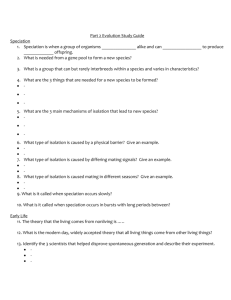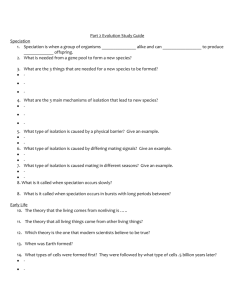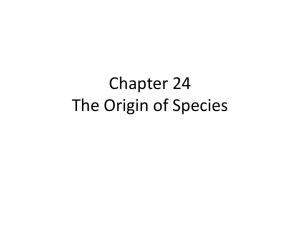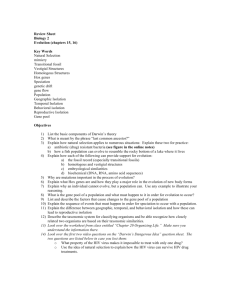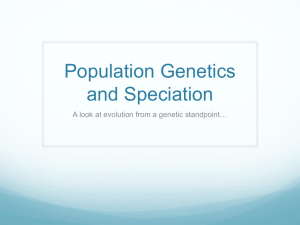Chapter 16: Population Genetics and Speciation
advertisement
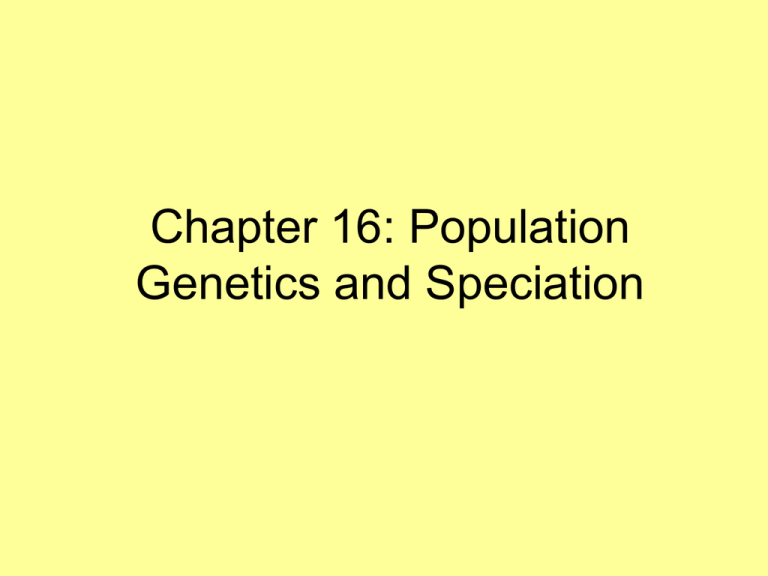
Chapter 16: Population Genetics and Speciation • Darwin died in 1882 • general acceptance of natural selection and evolution • Within the next century we gained knowledge of genetics and were able to strongly link genetics with theories of evolution and natural selection Variation of Traits Within a Population • Population genetics = the study of evolution from a genetic point of view • Microevolution = evolution at the genetic level, or a change in the collective genetic material of a population • Population = a group of individuals of the same species that routinely interbreed; smallest unit in which evolution can occur Bell curve • In nature, many quantitative traits in a population (i.e. height and weight) tend to show variation that follows a bell curve pattern What causes Variation? • Environmental factors – Food available • Heredity – Range of phenotypic possibilities (i.e. body size) – Set of specific phenotypes (i.e. possible flower colors) – Phenotypes within families (resemble family members but not identical to; different combinations of genotypes and therefore phenotypes) Populations have Gene Pools • gene pools are used to describe the total genetic information available in a population – If you could know all the alleles present in this imaginary pool you could use probability to predict expected genotypes & their frequencies for the next generation Why do genes vary? (Reasons we know right now) • 1) Mutation – random change in a gene that is passed on to offspring • 2) Recombination – reshuffling of genes in a diploid individual (occurs during meiosis by independent assortment and crossing-over) Why do genes vary? (Reasons we know right now) 3) random pairing of gametes – because each organism produces large numbers of gametes (union by chance) • expression of some genes depend upon the presence or absence of other genes or factors in the environment Natural Selection can act on species variations in a number of ways Stabilizing Selection - individuals with average form of a trait have the highest fitness • average represents optimum for most traits •think about bird beak lab Directional Selection - individuals that display more extreme form of a trait have greater fitness than individuals with an average form of the trait • Peppered moth simulation Disruptive Selection - individuals with either extreme variation of a trait have greater fitness than individuals with average form of the trait • extremes are better than blends Genetic Equilibrium: a theoretical state • Based on assumptions about an ideal hypothetical population that is not evolving – No net mutations occur; that is, the alleles remain the same – Individuals neither enter nor leave the population – Population is large (ideally, indefinitely large) – Individuals mate randomly – Selection does not occur Equilibrium Condition #1: no net mutations occur; that is, the alleles remain the same Disruption: MUTATIONS o spontaneous mutation occur constantly at very low rates under normal conditions o exposure to mutagens (mutation-causing agents) o chemical o radiation Mutation • provide new alleles for a trait • many of them are harmful • although some have no effect – Natural selection operates only on genes that are expressed so it takes a very long time to eliminate harmful recessive mutations – In long run: beneficial mutations are a vital part of evolution Equilibrium Condition #2: individuals neither enter nor leave the population (population remains constant) Disruption: GENE FLOW o size of population remains constant o remember if an individual moves, genes move with them! Gene Flow Immigration - the movement of individuals into a population Gene Flow Emigration - the movement of individuals out of a population Gene Flow Gene Flow -the process of genes moving from one population to another - migration of individuals -dispersal of seeds or spores Example • common baboons live on eastern African savannas in social/breeding groups called troops (10-200 members) – A few adult males dominate the troop; young and less dominant males leave their birth, eventually joining another troop Equilibrium Condition #3: the population is large (ideally, infinitely large) Disruption: GENETIC DRIFT o allele frequencies in a population change as a result of random events, or chance o in small populations the failure of even a single organism to reproduce can significantly disrupt the allele frequency of the population o if there is no variation, then extinction results due to natural selection Equilibrium Condition #4: individuals mate randomly Disruption: NONRANDOM MATING o many species do not mate randomly o Geographic proximity can result in some degree of kinship o Amplify certain traits o Offspring with disorders caused by recessive genes o Individuals may select a mate that has traits similar to their own traits (assortative mating) Nonrandom Mating continued… Sexual Selection - tendency of females to males to mate with based on certain traits - EXAMPLE: male peacock feathers Reminder: natural selection favors an increase in the genes of successful REPRODUCERS, rather than merely those of successful SURVIVORS. Equilibrium Condition #5: selection does not occur Disruption: NATURAL SELECTION OCCURS! o some members of population are more likely to survive and reproduce over others and thus are able to contribute their genes to the next generation o traits such as body size or color o trait distribution in a population may change when natural selection is at work over time o shift away from bell curve Formation of Species Speciation - process of species formation; results in closely related species Morpholgical Concept of Species • Morphology - internal and external structure and appearance of an organism – Used to be the chief criterion for classifying it as a species • Has limitations though: e.g. phenotypic differences among individuals in a single population • Some individuals that appear different enough to belong to different species interbreed in the wild and produce fertile offspring The Biological Species Concept • Ernst Mayr (1904-2005) – (German born, American Biologist) proposed the biological species concept which states that a species is a population of organisms that can successfully interbreed but cannot breed with other groups – We cannot test this concept with extinct organisms of the past; some organisms’ reproductive capacity compatibility cannot be tested; does not work for organisms that do not reproduce sexually Blend of ideas = current definition • Species = a single kind of organism whose members are morphologically similar and can interbreed to produce fully fertile offspring. Speciation begins with: GEOGRAPHIC ISOLATION • Geographic isolation = the physical separation of members of a population – Habitat divided (e.g. deep canyon develops; river changes course; drying climate in a valley) – Natural selection and genetic drift cause the two populations to diverge to the eventual point of being incompatible for mating – Organism: can you move around? e.g. birds can fly across a canyon Allopatric Speciation • Allopatric speciation happens when species arise as a result of geographic isolation – – – – Means “different homelands” Geographic barrier = no more gene flow between them More likely in small population (smaller gene pool) If the geographic barrier is removed, could the groups interbreed and produce fertile offspring? http://evolution.berkeley.edu/evolibrary/article//evo_45 Sympatric Speciation - occurs when 2 subpopulations become reproductively isolated within the same geographic area - population dies or lives in one spot, some individuals move; eventually groups will not breed Reproductive Isolation - results from barriers to successful breeding between population groups in the same area Reproductive isolation and the new species formed from it may result through disruptive selection (two extremes are selected for and begin to diverge) o Once successful mating is prevented, it’s like the pattern of geographic isolation THERE ARE TWO TYPES OF REPRODUCTIVE ISOLATION: PREZYGOTIC ISOLATION POSTZYGOTIC ISOLATION Prezygotic Isolation pre-mating isolation occurs before fertilization can reduce the chance of hybrid formation e.g. a mating call that is not recognized as such by a potential mate e.g. different peak mating times Postzygotic Isolation post-mating isolation occurs after fertilization e.g. different breeding times offspring of interbreeding species may not develop completely and may die early; or live but not be fertile Rates of Speciation Gradualism - idea that speciation occurs at a regular, gradual rate - some scientist disagree: they think it happens in “bursts” relative to the geologic time scale Rates of Speciation Punctuated Equilibrium - change occurred in a few thousands years rather than a few million - periods of little change - sudden, rapid changes - e.g. see periods of no change with some cases of great diversity of new forms evolved rapidly in fossil record

